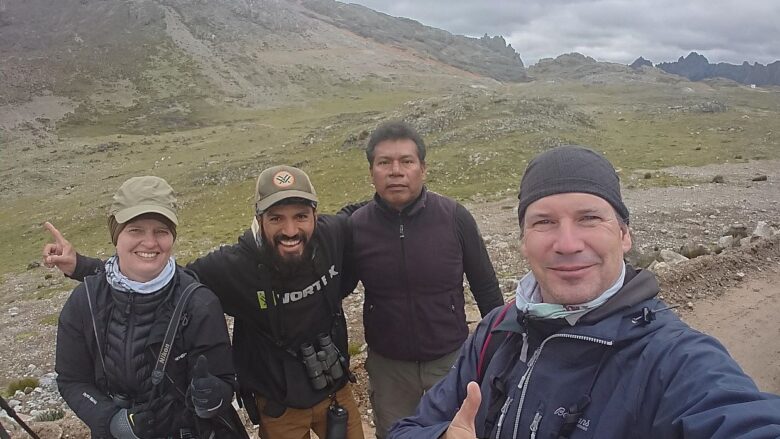This post is also available in: Dansk
All photos © Bente Steffensen and Uffe Damm Andersen, unless otherwise stated.
Three Intense Days of Birding in Peru
It was still dark and drizzling when Gustavo and Julio picked us up in the Miraflores neighborhood where we lived. We drove through the strangely empty and quiet metropolitan streets of Lima, but then again, it was only 5 in the morning. We were heading for the first stop of the morning, a vantage point on the Pacific coast where we hoped to see the endemic Surf Cinclodes.
In March 2019 we were in Peru. We were to spend the next three days with our friend Gustavo – one of Peru’s top birders – and Julio who was our driver. Gustavo was on holiday in Lima and he wanted to go birding with us and before long we had planned three intense days of birding.
We were looking forward to three really great days in good company, with many exciting birds, impressive landscapes and wild roads. Furthermore, we expected that our “Peru bird list” would soon grow longer – including some endemic species.
An endemic Cinclode at dawn
We spent the first of the three intense days of birding, in the heat of the lowlands south of Lima and along the Pan-American Highway.
It wasn’t really hot yet when we arrived at the vantage point of El Salto del Freile. The rain had largely stopped and as the sun had not yet risen over the mountains the Pacific coast was still dark. In the early dawn, there was just enough light to see the first gulls (Franklin’s, Kelp and Gray-hooded Gull) and a couple of Inca terns flying past the coast.
With binoculars, we looked for movement between the rocks on the rocky coast below us. After about ten minutes, a small bird disappeared behind a rock. The size and color looked right, but it was too brief a glimpse to be sure. Soon the bird appeared again. It moved quickly between the rocks, but we managed to see it clearly enough that there was no doubt about the species – Surf Cinclode. Check – the first target species of the day was in the books.

Thick knees, a multicolored bird and penguins!
After the cinclode, we drove a little further south to Villa Marshes. It is a large wetland located on the coast and therefore it is not surprising that waterfowls are dominant. There were different species of ducks, shorebirds and several thousand gulls – mainly Franklin Gulls. Besides the birds, there were also many mosquitoes!
We started by looking for a bird with thick knees – the Peruvian Thick-knee – as the species is called in English. I do not know if it has particularly thick knees and its Danish name is Perutriel. But as both the English and Danish names indicate, it is a species one must go to Peru to see.
But regardless of the thickness of the knees, the bird was not very cooperative. It took a while before we managed to find four of them – resting on the empty beach under a few beach umbrellas!

Over the course of the day, we saw a lot of birds and it was not exclusively waterfowl. In the reeds, we saw several of the small and beautiful Many-colored Rush Tyrant, whose name is very fitting when you look at the male’s plumage.
We also saw species such as Wren-like Rushbird, Peruvian Meadowlark, even an Osprey and up to several Burrowing Owls.
But the biggest surprise of the day was two Humboldt Penguins, who rested briefly at sea not far from shore. They disappeared somewhere in the surf and although we know for sure that they did not fly away we were unfortunately not able to find them again.

The Main Course
The birding in the lowlands was only the starter of the three intense days of birding. Now it was time for the main course, as Gustavo very aptly described what awaited us in the coming days.
We were going up into the Andes. Specifically, the Santa Eulalia Canyon northwest of Lima. The valley is probably best known by birdwatchers and it is due to the many exciting bird species that can only be found in the Andes and some of the species you find almost no other place than this particular valley.
In the Santa Eulalia valley and in the upland areas you will find a very beautiful and spectacular landscape. You reach the valley after a few hours’ drive from Lima. From about 2200 meters above sea level where we started the birding, you drive along a narrow dirt road that winds for many kilometers through the canyon until you reach the pre-puna and later the puna itself – the high plateau landscape situated at above 3500 m elevation.
We were going to look at birds in the canyon and up on the puna, which meant that for the next few days we would spend much of the time in the thin air of more than 3000 m elevation.
It was not the first time we were up in these altitudes and we were well prepared and although we have not had any problems with the altitude or the thin air in the past, we had for safety brought a few bottles of coca tea on the trip.

A wild road
If you choose to take the trip through the canyon, you can expect to experience nervous tics. The road is not for people who suffer from acrophobia. It runs on very steep – in some places vertical – mountainsides with free view several hundred meters down the valley.
Along the roadside, many boulders were proof that it is a dynamic landscape. Not only do you need to be careful not to go over the edge, but you also have to watch for fallen rocks from above. It is not unusual for the road to be blocked due to a landslide! At one point, our car had to go all the way to the edge – and it really was all the way to the edge – to get past a large boulder that blocked the road. But we managed to edge by after some nerve-wracking minutes where Gustavo got out and guided the car past.
Afterward, we don’t quite understand why we stayed in the car! In hindsight, it would have been wiser if we had stepped out too, and walked past the boulder. At the same time, it would have been possible to get some dramatic pictures. But I think it wasn’t until afterward that we realized how close to the edge we actually had been. Julio was so calm during the whole situation so we barely got to worry.

The car horn is used
Fortunately we did not meet many oncoming cars, because there was not much room and you could not see on the other side of the sharp turns. For the same reason, the car horn is also used just before a sharp turn to alert any oncoming drivers to one’s presence. The ones we met came almost out of the blue when driving into a sharp turn, but Julio was a very skilled and experienced driver.
The Landscape and the birds change
The day had seen many birds in the valley among them several of our target species – including Mountain Parakeet, Thick-billed Miner and Great Inca Finch. We saw Peruvian Sheartail – a hummingbird with a pair of elongated tail feathers – and the small hummingbird Purple-collared Woodstar while looking for one of the area’s absolute must-see species – Black-necked Woodpecker.

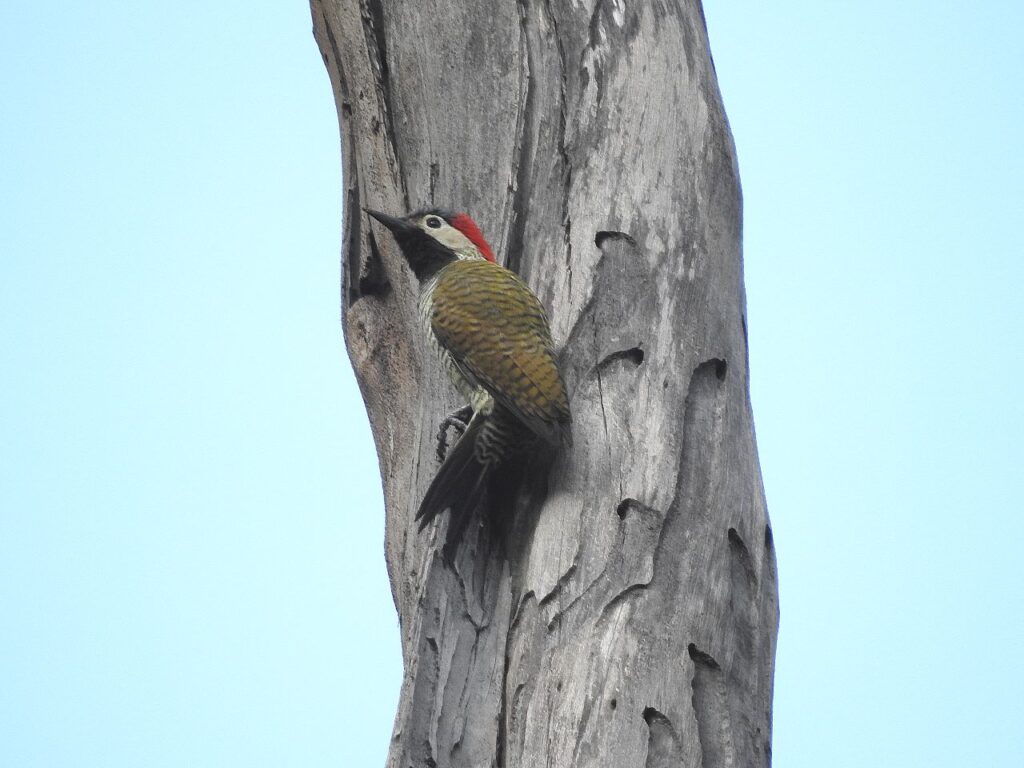
The landscape had changed significantly as we moved higher up during the day. The vertical slopes and deep gorges had been replaced by open plains that characterize the Puna grassland. The vegetation is very low and mostly without shrubs. There are small lakes and bogs.
The bird fauna also changed and now it was species such as Andean Goose, Puna Ground-Tyrant, Black Siskin and White-winged Diuca-finch. Species adapted to the climate and ecosystems of the Highlands between 3000 – 5000 m elevation.

4 DSP at 4712 m.a.s.l.
It was late afternoon and we were 4712 meters above sea level. The light would soon disappear and the barren terrain was shrouded in clouds and the visibility had decreased. The temperature was now below freezing. The fatigue had gradually begun to set in and the body was feeling the sting of the cold.
But we were not done yet. There was still a target species on the agenda – we were looking for DSP!
DSP is eBird lingo for the wading bird Diademed Sandpiper-plover because it is the “quick” entry abbreviation in the eBird app (read more about eBird). DSP is both easier and faster to say, so it was, of course, what we called the wader.
This wading bird has long been on our target list, and now we finally had an opportunity to see the bird. We quietly scanned the bog in front of us, hoping that luck was on our side.
The Diademed Sandpiper-plover lives at 3500 – 5000 m elevation and has a range extending from central Peru to the southern regions of central Chile and Argentina. But it is not very common and it takes both luck and patience to succeed. It greatly helps to have local knowledge, and here we were well covered with both Gustavo and Julio, who know the area.
And we did succeed – there were Diademed Sandpiper-plovers in the bog. There were four birds – two adults with their two little downy chicks!
But I have to say, they were hard to spot as they blended into the surrounding vegetation. It was a good ending to a long and great day.


A special Target Species
The following day began with observations of DSP. We had stayed at a small hotel in San Mateo, a small town located at 3200 m elevation. To have the most field time possible for the last of three intense days of birding, we had decided to take the morning coffee and breakfast in the field. That is why we were now back where we had ended the previous day.
The coffee warmed us because it was cold and the countryside was covered with rime ice in several places – and something that looked like snow.
Part of the morning we tried to find Puna Tinamou. And yes, you remember correctly – we have written about tinamous on the blog previously. If you haven’t read the story or want to reread it, you can find it here: Can you set your watch after a bird?
The Puna Tinamou was a special target species. A target species is a species that you want to see for some reason. For us, all species that we have not seen before are in principle target species. But often it is rare species, special species or endemic species – or just one species that is still missing from your list.
The Puna Tinamou was missing from our list (yes, there are many lists in the world of birding and certainly enough material for a whole article just about lists) for obvious reasons, as we have not been to Peru or other countries where it lives. The special thing about this target species was that Gustavo had never actually seen the Puna Tinamou either, and he really hoped that this would be the day that he finally succeeded.
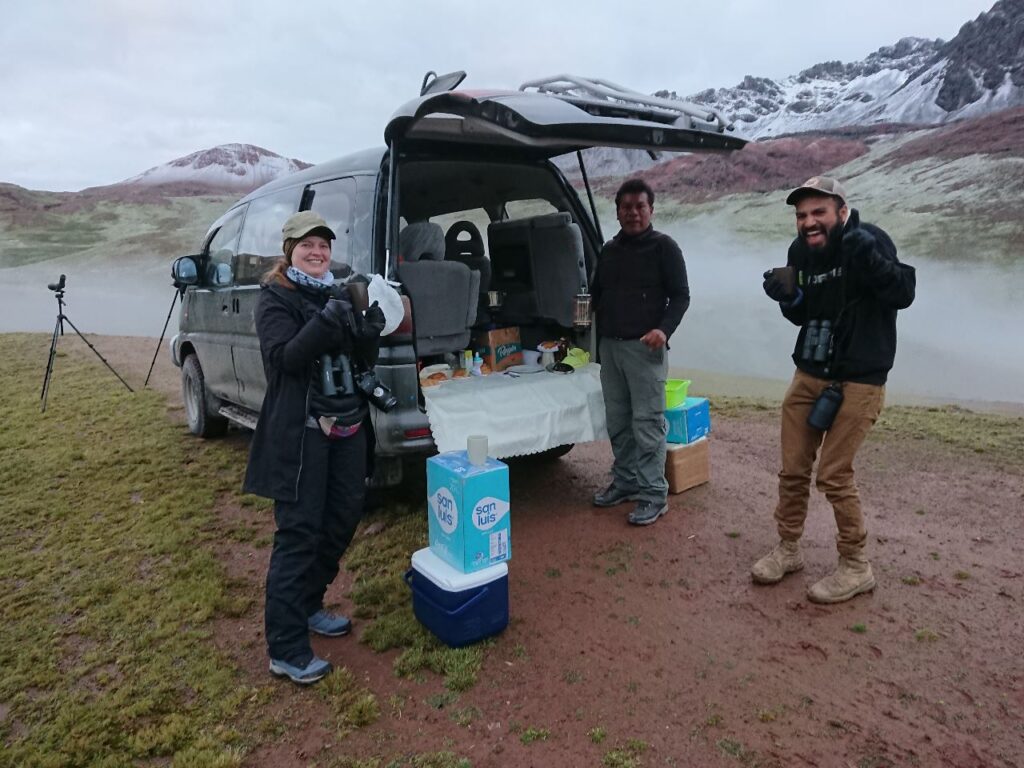
In the thin air
At an altitude of 4900 meter, we patiently scanned the hillsides where our driver Julio has seen the tinamou several times before. We even used playback, but there was no response, so eventually, we gave up and left the area. Julio knew another place where we could try again later in the day.
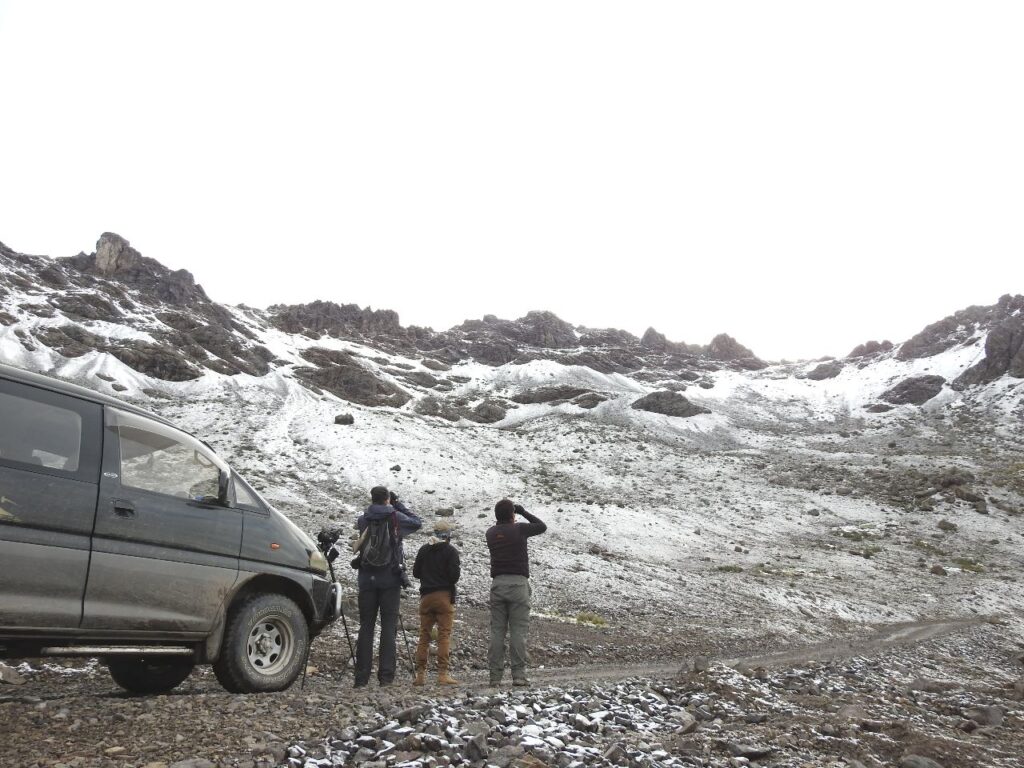
During the next couple of hours we saw several exciting birds. In addition to the four DSPs we saw during breakfast, 52 Andean Lapwing flew by at one point. Later, it became species such as the Gray-breasted Seedsnipe and Punasnipe, Buff-breasted Earthcreeper and Dark-winged Miner, White-fronted Ground Tyrant and Bright-rumped Yellow-finch.
We also managed to see – quite clearly as well – one of the really exciting species, the endemic White-bellied Cinclode, found only in a very small area of Peru and at altitudes above 4400 meters.
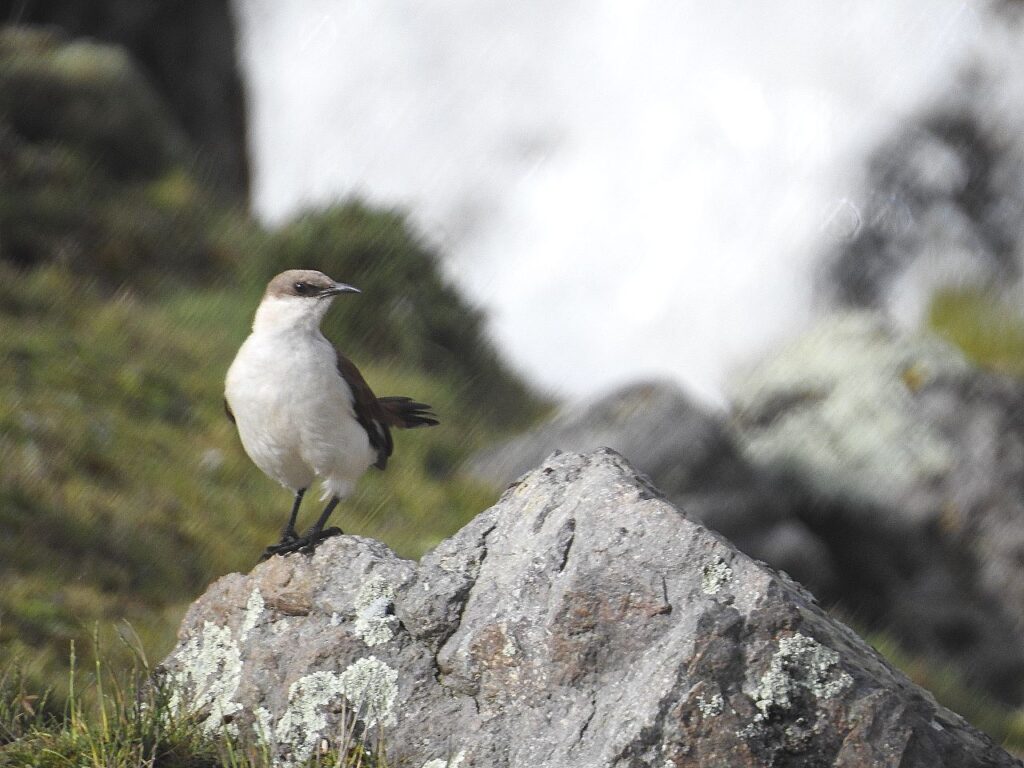
Top birder gets a lifer at 4800 m above sea level
It was about nine in the morning, and we stood at nearly 4800 meters above sea level and looked over at the hillside where Julio had previously seen the Puna Tinamou. It was quite far to the hillside from the dirt road where we stood, and so the rocky terrain was thoroughly searched with binoculars and telescopes. But we saw no birds nor the slightest movement.
After some time, we decided to try playback again. We listened – but no reaction came. Waited a while and then tried again, but still without response. Julio’s experience was that the Puna Tinamou usually responded immediately when using playback. So it did not appear that there were any in the area.
Response!
We decided to give up on the tinamou again and got ready to move on. But we decided to just try the playback one last time – response! We heard the strange cackling voice of the Puna Tinamou cleary somewhere over on the hillside. It sounded like there was more than one – but where were they?
In the end, Gustavo, who really wanted to see the tinamou, walked across the valley and climbed the hillside.
Through the telescopes we followed Gustavo, who slowly crept forward on the slope. And suddenly they were there – three individuals. At one point they stood freely on a large boulder before taking flight and flying a long distance before landing again. Fortunately, we quickly found them again and were able to follow them for a while as they ran around on the ground. This meant that we also got some documentation photos, which we always want when it is the slightly more special species we see.

It was a very happy Gustavo who came back to us. A top birder had gotten a lifer and could now check the Puna Tinamou off his target list.

All photos © Bente Steffensen and Uffe Damm Andersen, unless otherwise stated.

